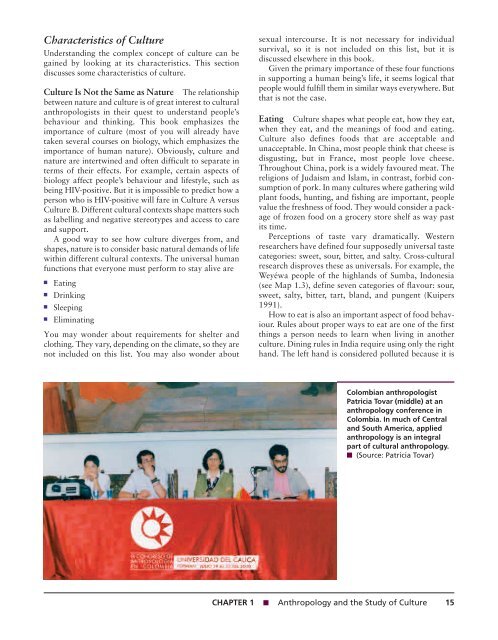PART Introduction to Cultural Anthropology - Pearson Canada
PART Introduction to Cultural Anthropology - Pearson Canada
PART Introduction to Cultural Anthropology - Pearson Canada
You also want an ePaper? Increase the reach of your titles
YUMPU automatically turns print PDFs into web optimized ePapers that Google loves.
Characteristics of Culture<br />
Understanding the complex concept of culture can be<br />
gained by looking at its characteristics. This section<br />
discusses some characteristics of culture.<br />
Culture Is Not the Same as Nature The relationship<br />
between nature and culture is of great interest <strong>to</strong> cultural<br />
anthropologists in their quest <strong>to</strong> understand people’s<br />
behaviour and thinking. This book emphasizes the<br />
importance of culture (most of you will already have<br />
taken several courses on biology, which emphasizes the<br />
importance of human nature). Obviously, culture and<br />
nature are intertwined and often difficult <strong>to</strong> separate in<br />
terms of their effects. For example, certain aspects of<br />
biology affect people’s behaviour and lifestyle, such as<br />
being HIV-positive. But it is impossible <strong>to</strong> predict how a<br />
person who is HIV-positive will fare in Culture A versus<br />
Culture B. Different cultural contexts shape matters such<br />
as labelling and negative stereotypes and access <strong>to</strong> care<br />
and support.<br />
A good way <strong>to</strong> see how culture diverges from, and<br />
shapes, nature is <strong>to</strong> consider basic natural demands of life<br />
within different cultural contexts. The universal human<br />
functions that everyone must perform <strong>to</strong> stay alive are<br />
■ Eating<br />
■ Drinking<br />
■ Sleeping<br />
■ Eliminating<br />
You may wonder about requirements for shelter and<br />
clothing. They vary, depending on the climate, so they are<br />
not included on this list. You may also wonder about<br />
sexual intercourse. It is not necessary for individual<br />
survival, so it is not included on this list, but it is<br />
discussed elsewhere in this book.<br />
Given the primary importance of these four functions<br />
in supporting a human being’s life, it seems logical that<br />
people would fulfill them in similar ways everywhere. But<br />
that is not the case.<br />
Eating Culture shapes what people eat, how they eat,<br />
when they eat, and the meanings of food and eating.<br />
Culture also defines foods that are acceptable and<br />
unacceptable. In China, most people think that cheese is<br />
disgusting, but in France, most people love cheese.<br />
Throughout China, pork is a widely favoured meat. The<br />
religions of Judaism and Islam, in contrast, forbid consumption<br />
of pork. In many cultures where gathering wild<br />
plant foods, hunting, and fishing are important, people<br />
value the freshness of food. They would consider a package<br />
of frozen food on a grocery s<strong>to</strong>re shelf as way past<br />
its time.<br />
Perceptions of taste vary dramatically. Western<br />
researchers have defined four supposedly universal taste<br />
categories: sweet, sour, bitter, and salty. Cross-cultural<br />
research disproves these as universals. For example, the<br />
Weyéwa people of the highlands of Sumba, Indonesia<br />
(see Map 1.3), define seven categories of flavour: sour,<br />
sweet, salty, bitter, tart, bland, and pungent (Kuipers<br />
1991).<br />
How <strong>to</strong> eat is also an important aspect of food behaviour.<br />
Rules about proper ways <strong>to</strong> eat are one of the first<br />
things a person needs <strong>to</strong> learn when living in another<br />
culture. Dining rules in India require using only the right<br />
hand. The left hand is considered polluted because it is<br />
Colombian anthropologist<br />
Patricia Tovar (middle) at an<br />
anthropology conference in<br />
Colombia. In much of Central<br />
and South America, applied<br />
anthropology is an integral<br />
part of cultural anthropology.<br />
■ (Source: Patricia Tovar)<br />
CHAPTER 1 ■ <strong>Anthropology</strong> and the Study of Culture 15
















